Click here to read on Classy.
When it comes to nonprofit email marketing, organizations face a specific set of challenges like constantly creating new messages, not coming off as desperate, and avoiding inbox blindness where donors skip over your emails.
The good news is that nonprofit emails have four times the open rate of typical marketing emails. However, it’s what happens after the open that determines whether or not you get a donation.
The key is to send the right messages at the right time. Below, we break down nine nonprofit email marketing examples that any organization can use as part of their next campaign.
Don’t forget to register to learn all about nonprofit marketing from email communications to creative fundraising at the free, can’t-miss virtual nonprofit conference of the year.
Register for the Collaborative: Virtual Sessions
1. Welcome Emails
When you get new email subscribers, it’s imperative you provide them with a warm welcome. Not only do welcome emails help you put your best foot forward, but they can also increase your chances of getting donations down the line.
Welcome emails boast four times higher open rates and five times higher click-through rates than traditional emails, according to a recent Experian study. What’s most striking for nonprofits is the fact that welcome emails result in eight times the transaction rate of a promo email. In that light, your welcome email series is crucial in securing donations.
Take a look at this welcome email example from Save the Children. It accomplishes three things necessary for an effective welcome series:
- Sets a positive tone with your list
- Provides expectations for what subscribers can look forward to in the future
- Highlights the value of your organization
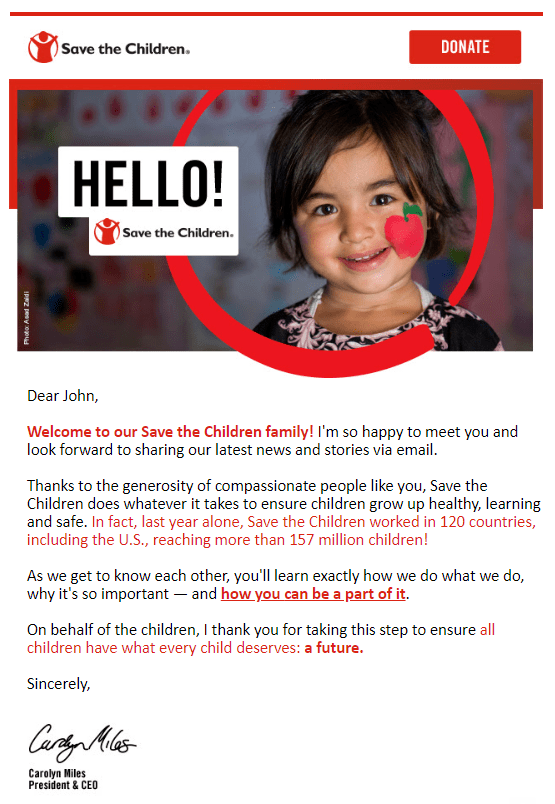
2. Storytelling Emails
No matter what your cause might be, stories are a central part of your nonprofit email marketing strategy because they draw readers in emotionally. This approach makes people more psychologically inclined to donate.
Try not to box yourself into thinking of a story only in terms of text. You can also use photos to tell a compelling and emotional story.
This email from WWF is a shining example of mixing imagery with compelling copy.
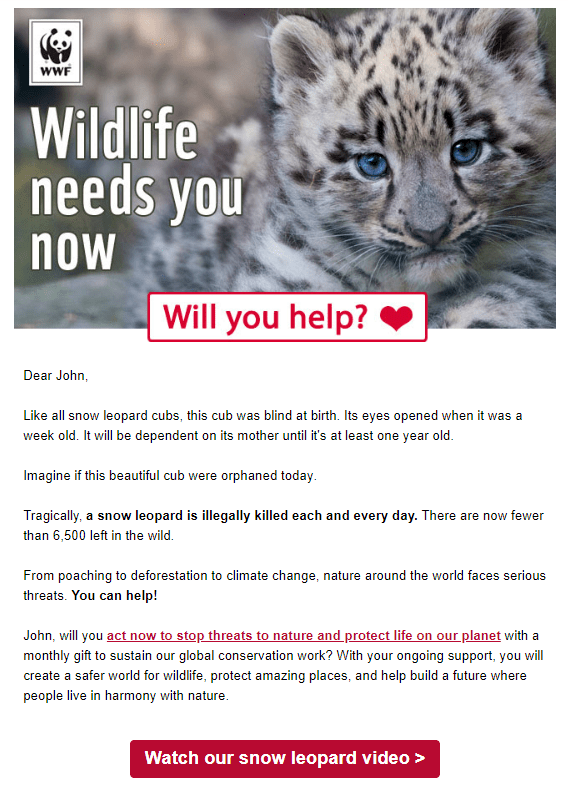
The first thing you see is a large, striking photo of a snow leopard looking straight at you, making an instant connection (especially given that some of us are wired to care as much about animals as people). Then, by addressing the reader by name and asking a question directly (“will you help stop threats…”), the message both starts and ends on an emotional note, supported by statistics on the mistreatment of leopards.
Whether it’s a personal anecdote from your founder or a tale from the field, make sure to get personal with your content.
If you keep up a blog, storytelling emails are a fantastic way to encourage your readers to read your latest post and ideally donate. Check out how the St. Baldrick’s Foundation does it:
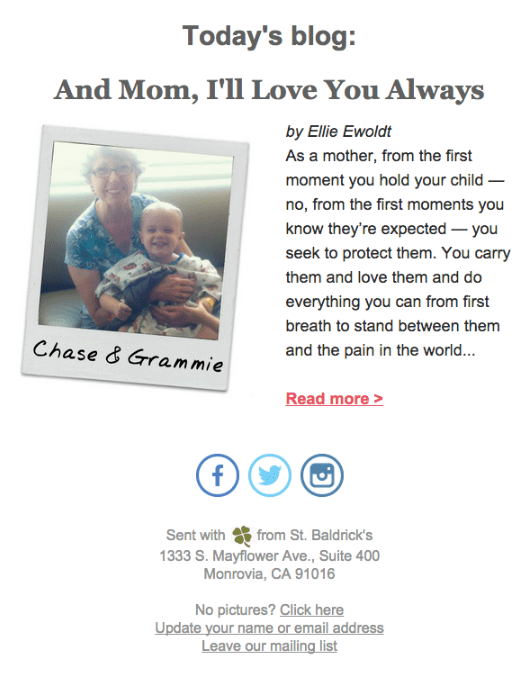
3. “Thank You” and Update Emails
Simple “thank you”s and updates are a great tool that can help improve donor retention.
By opting in to your emails, subscribers signal that they want to be kept in the loop. Providing the updates keeps these supporters engaged with your organization and coming back to donate again.
Some ideas you can use in your update emails include:
- Major milestones for your nonprofit, like raising a certain amount of money or helping a certain number of people
- Celebrating your organization’s anniversary
- New programs, campaigns, or initiatives your nonprofit is rolling out
This progress update message from charity:water is a good example of an update email in action. It highlights specifics such as where the donation is going, how many projects have been funded so far, and just how close the project is toward reaching its goal.
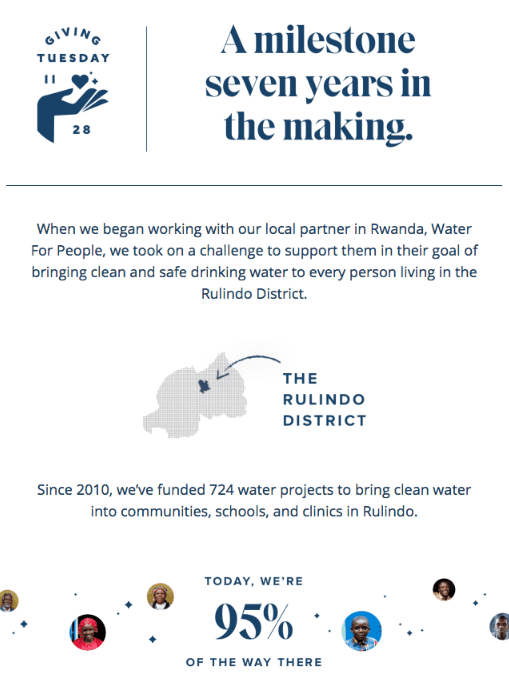
Highlighting the specific outcomes of donations creates a feel-good moment for your subscribers. Small touches such as the “You are here” marker in the timeline below make donations in question seem more tangible.
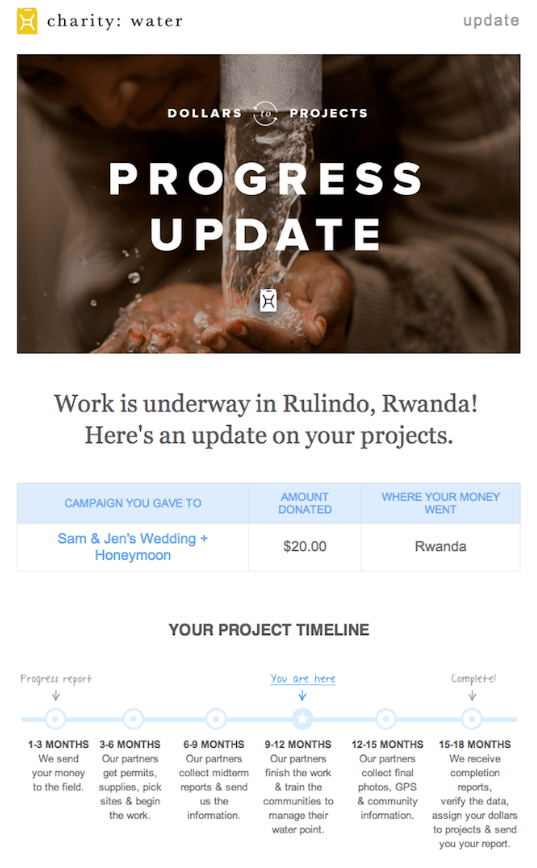
Framing these sorts of updates as “thank yous” can help increase opens and click-throughs as well.
In fact, “thank you” emails have an average engagement rate of 62 percent. A HubSpot study also notes that “thank yous” receive double the click-through rate of any other type of message.
4. Holiday Emails
The majority of charitable giving happens during the holidays, and email is not just a fantastic way to capitalize on that—it’s necessary.
For example, the boom of charitable donations on Facebook right now in lieu of birthday or holiday gifts is also telling. Suggest that people make donations in honor of others rather than providing material gifts.
This holiday message from Deki is a straightforward example of how nonprofits can solicit donations during the holidays, ultimately framing donations as gifts.
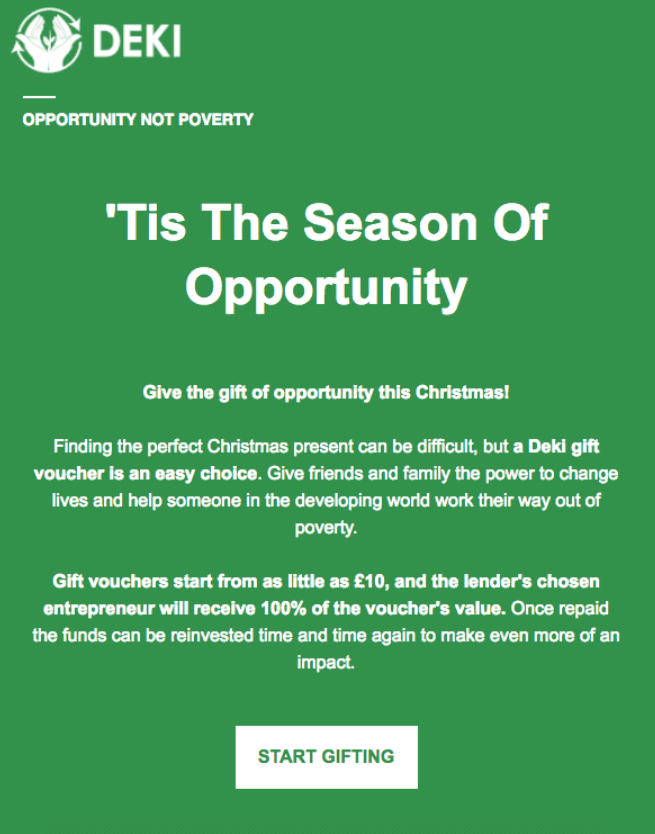
Don’t be afraid to push for donations during the holidays because people expect it and they’re ready to answer the call.
5. Number and Statistic-Based Emails
Standing out in your subscribers’ inbox can be an uphill battle, but numbers and statistics in your subject lines are a way you can immediately grab someone’s attention. Here are a couple examples:
- There are 844 million people without access to clean water worldwide.
- One in five children lacks proper access to food annually in the United States.
Build them into the body of your email as well. Check out how the example below uses stats to grip people and demonstrate the intensity and urgency of a situation.

Another way to both educate and grab your reader’s attention is by including an infographic within your email. This one from Habitat for Humanity of Florida sheds light on the sort of figures nonprofits can integrate into their marketing campaigns.
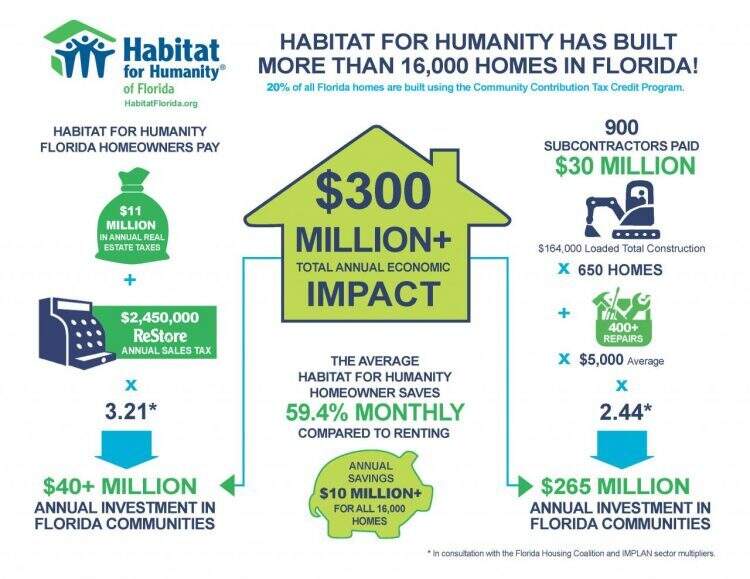
6. Matching Donation Emails
Donation matches are the number one factor that invites donors to give more, according to 2017 data from Double the Donation. Similarly, the same report noted that 84 percent of donors would be more likely to give if their donations were matched.
Reserved for special promotions and used sparingly, messages like this one from WE tend to resonate with readers. The notion of doubling your impact combined with hopeful copy (“It’s never too late to change the world”) make this one a winner.
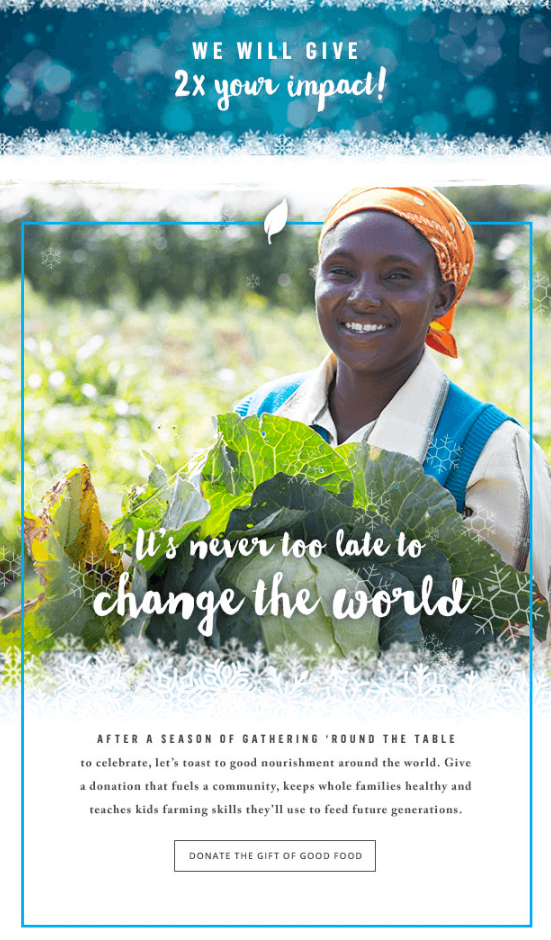
While you can run a donation match during any campaign, it’s a great tool to leverage especially during the holidays, as Sevenly demonstrates here.
The bold “2” (remember what we said about stats and figures being easy to digest) and “Double Your Pledge” call to action to do double duty make donors feel like they’re getting the maximum value out of their pledge.
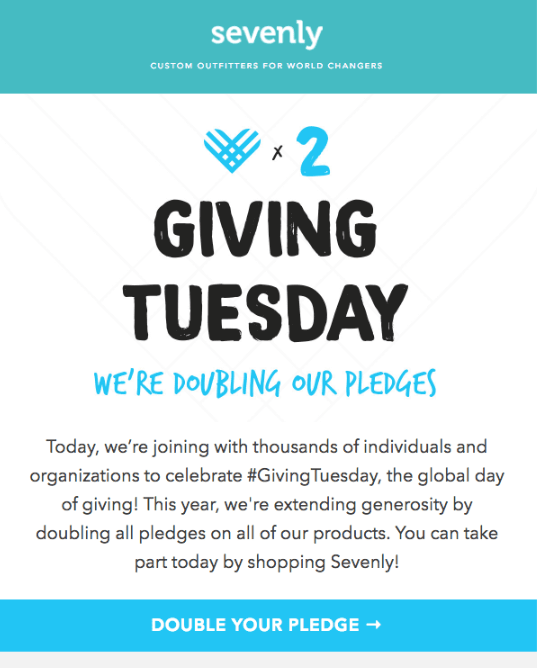
Although you can’t match all the time, it’s also a great way to acquire new first-time donors.
7. Question and Survey Emails
When you’re competing with the likes of social media and chatbots, anything you can do to open up the lines of communication and make your emails interactive is a major plus.
This rings true in terms of keeping readers engaged and learning more about them for future emails.
That’s why surveys and question-based messages like this one from the World Wildlife Fund (WWF) are such a smart move:
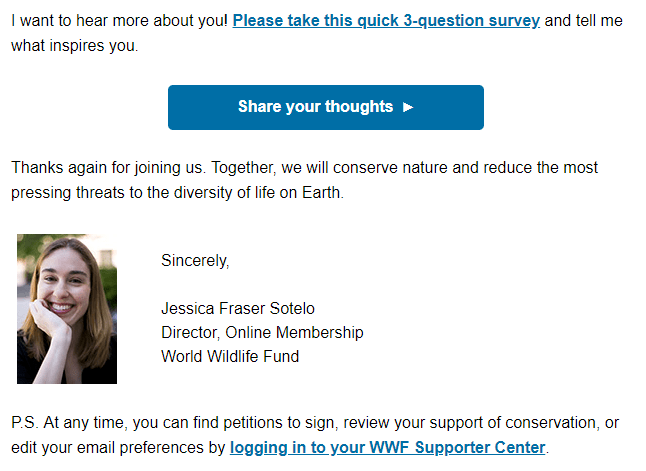
Leading to a detailed questionnaire, these sorts of emails do double-duty as you learn more about your subscribers and better segment your list.
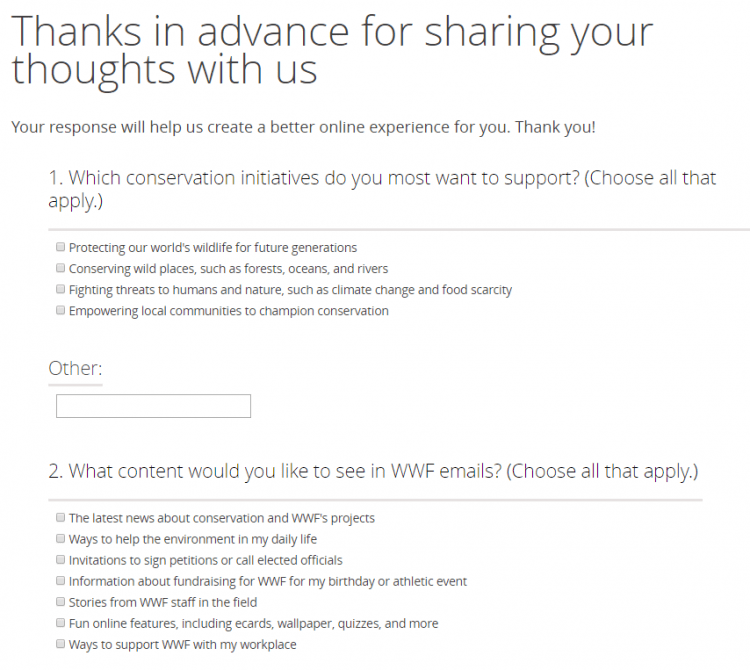
Letting your readers know you’re listening can help distinguish you from competitors in their inbox who constantly bombard them with offers.
According to FastCompany’s 1,000 cold email experiment, question-based emails which pick readers’ brains resulted in a flurry of replies.
Also, snappy surveys help nonprofits achieve a much-needed sense of personalization for providing the right messaging. By surveying your subscribers directly, you can fine-tune your emails in the future.
8. The Minimalist Email
Not all emails need to be major productions.
A “less is more” mentality with your nonprofit email marketing strategy not only requires less legwork on your part, but it’s also easier on your readers.
Consider that your subscribers’ time is valuable and the average attention span for adults is nine seconds.
With fewer points to drop off or lose your readers’ attention, short emails with simple copy tend to convert better than lengthier ones. This approach also makes it harder for your readers to miss your CTA.
Brief messages like this one from UNICEF certainly pack a punch with its impactful design and clear CTA:
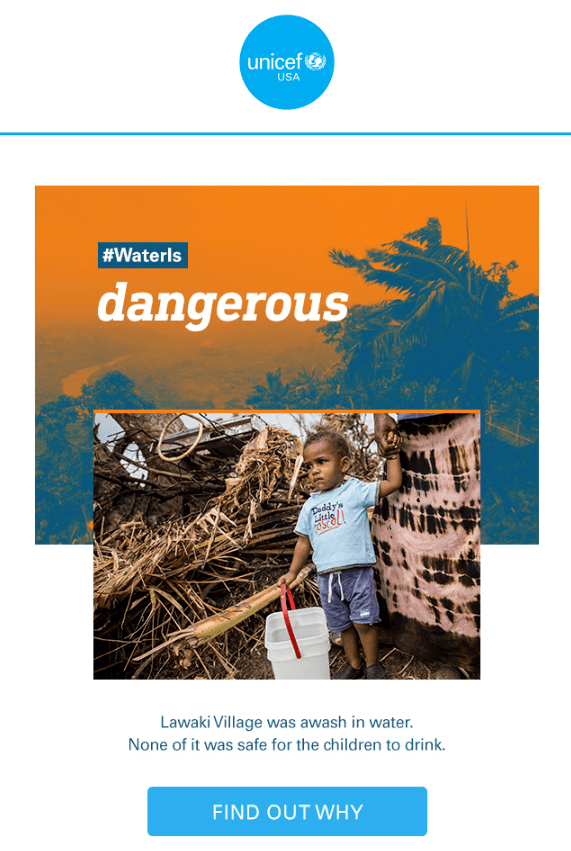
Likewise, this “learn more” copy and positive imagery from charity: water is a great example of a minimalist email that encourages clicks:

Soliciting donations via nonprofit email marketing doesn’t have to happen within the confines of your messages. Getting their attention and encouraging that ever-so-important click-through is what matters as you can let a long-form landing page do the rest.
9. “Success Story” Emails
Last but not least, don’t forget the need to provide your donors with stories of your organization’s success and how they’ve contributed.
Highlighting specific success stories or instances of someone benefiting from your nonprofit provide concrete proof of your organization’s impact.
In a day and age where one-third of Americans are skeptical of charitable organizations, that proof certainly matters.
This email from charity: water highlights an actual instance of donations in action by telling the story of Srey and her family in Cambodia. Showing off Srey herself and her new water filter serve as proof that donations are doing legitimate good.
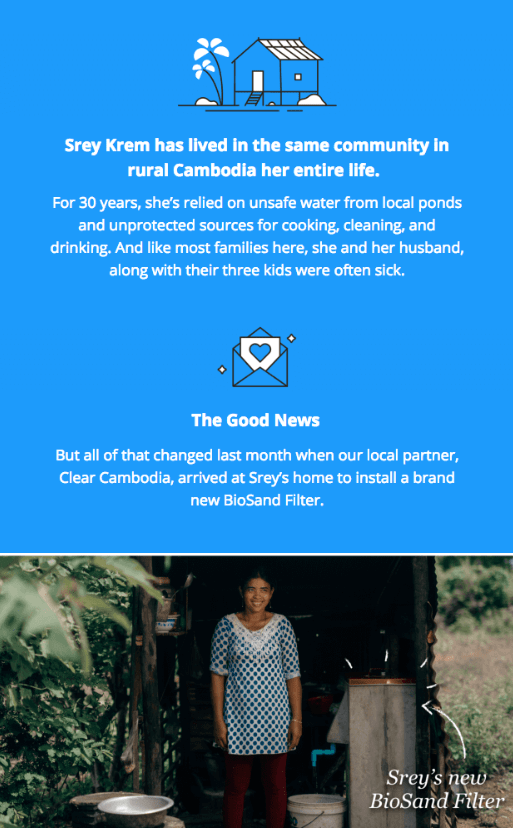
Sticking to the principle of “show, don’t tell,” social proof is proven to increase email engagement. Whether it’s testimonials, smiling faces, or that stats from a fundraising goal, showcase the broader community that has contributed to your cause and make your reader feel proud to be a part of it.
How Diverse Is Your Nonprofit Email Strategy?
Nonprofits must do everything in their power to encourage readers to convert into donors. Diversifying your nonprofit email marketing strategy with these nine types of messages, as well as others, can help you accomplish that goal.
So rather than scramble for fresh ideas, look inward to see how you can start incorporating high-converting elements into your emails.
Return to Insights & Events
